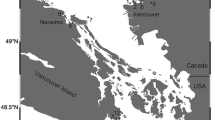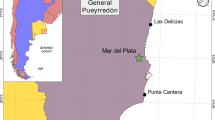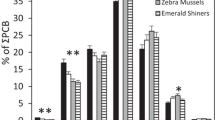Abstract
The concentrations of six polychlorobiphenyl (PCB) congeners in sediments and four classes of biotic species of the aquatic food chain were investigated in a freshwater lake near Amsterdam. Despite the low concentrations of the contaminants in the sediment, significant amounts of PCBs were found in plankton, macro-invertebrates and fish. The composition of the PCB mixtures found in the various organisms cannot be explained in terms of simple partitioning of the PCB congeners between sediment, water, and organisms. In addition to bioconcentration, it is likely that biomagnification via consumption of contaminated food also contributed significantly to the total PCB concentrations. This is most pronounced for the higher trophic food-chain organisms. Studying bioaccumulation processes by monitoring just one type of organism is probably not very suitable, due to the pronounced differences in accumulation patterns demonstrated for the different organisms. In addition, significant differences were found in the accumulation of the six PCBs in the various biotic samples. This indicates that the fate of mixtures of PCBs is determined by the fate of the individual congeners and therefore cannot be monitored in terms of total PCBs concentrations.
Similar content being viewed by others
References
Biddinger GR, Gloss SP (1984) The importance of trophic transfer in the bioaccumulation of chemical contaminants in the aquatic ecosystem. Residue Rev 91:103–145
Bligh EG, Dyer WJ (1959) A rapid method of total lipid extraction and purification. Can J Biochem Physiol 37:911–917
Breck JE (1985) Comment on fish/sediment concentration ratios for organic compounds. Environ Sci Technol 19:198–199
Brown MP, McLauglin JJA, O'Connor JM, Wyman SG (1982) A mathematical model of PCB bioaccumulation in plankton. Ecol Modelling 15:29–47
Bruggeman WA, Martron LBJM, Kooiman D, Hutzinger O (1981) Accumulation and elimination kinetics of di-, tri-, and tetrachlorobiphenyls by the goldfish after dietary and aqueous exposure. Chemosphere 10:811–832
Bruggeman WA, Opperhuizen A, Wijbenga A, Hutzinger O (1984) Bioaccumulation of super-lipophilic chemicals in fish. Toxicol Environ Chem 7:173–189
Calambokidis J, Mowrer J, Beug MW, Herman SG (1979) Selective retention of polychlorinated biphenyl congeners in the musselMytilus edulis. Arch Environ Contam Toxicol 8:299–308
Chiou CT (1985) Partition coefficients of organic compounds in lipid-water systems and correlations with fish bioconcentration factors. Environ Sci Technol 19:57–62
Clayton JR, Pavlou SP, Breitner NF (1977) Polychlorinated biphenyls in coastal marine zooplankton: bioaccumulation by equilibrium partitioning. Environ Sci Technol 11:676–682
Connor MS (1984) Fish/sediment concentration ratios for organic compounds. Environ Sci Technol 18:31–35
Duinker JC, Hillebrand MTJ (1983) Composition of PCB mixtures in biotic and abiotic marine compartments. (Dutch Wadden Sea) Bull Environ Contam Toxicol 31:25–32
Eaton JG, Mattson VR, Mueller LH, Tanner DK (1983) Effects of suspended clay on the bioconcentration of kelthane in fathead minnow. Arch Environ Contam Toxicol 12:439–445
Geyer H, Scheunert I, Korte F (1985) Relationship between the lipid content of fish and their bioconcentration potential of 1,2,4 trichlorobenzene. Chemosphere 14:545–555
Gooch JA, Hamdy MK (1982) Depuration and biological half-life of14C-PCB in aquatic organisms. Bull Environ Contam Toxicol 28:305–312
Hiraizumi Y, Takahashi M, Nishimura H (1979) Adsorption of polychlorinated biphenyl onto sea bed sediment, marine plankton, and other adsorbing agents. Environ Sci Technol 13:580–584
Karickhoff SW (1984) Organic pollutant sorption in aquatic systems. J Hydraulic Engineering 110:707–735
Kenaga EE, Goring CIA (1980) Relationships between water solubility, soil sorption, octanol-water partitioning, and concentration of chemicals in biota. In: Eaton JG, Parrish PR, Hendrickx AC (eds) Aquatic toxicology. ASTM STP 707, Philadelphia PA, pp 78–115
Landrum PF, Nihart SR, Eadie BJ, Herche LR (1987) Reduction in bioavailability of organic contaminants to the amphipodPontoporeia hoyi by the dissolved organic matter of the sediment interstitial waters. Environ Toxicol Chem 6:11–20
McCarthy JF (1983) Role of particulate organic matter in decreasing the accumulation of polynuclear hydrocarbons byDaphnia magna. Arch Environ Contam Toxicol 12:559–568
Mebius L (1960) A rapid method for the determination of organic carbon in soil. Anal Chim Acta 22:120–124
Mowrer J, Aswalt K, Burgermeister G, Machado L, Tarradellas J (1982) PCBs in a Lake Geneva ecosystem. Ambio 11:355–360
Opperhuizen A, Jongeneel RJ (1986) Mixtures of hydrophobic chemicals in the aquatic environment: Aqueous solubility and bioconcentration in fish of Aroclor® 1254. In: Bjorseth A, Angeletti G (eds) Organic pollutants in the aquatic environment, D. Reidel, Dordrecht, pp 251–260
Opperhuizen A, VanderVelde EW, Gobas FAPC, Liem AKD, VanderSteen JMD, Hutzinger O (1985) Relationships between bioconcentration in fish and steric factors of hydrophobic chemicals. Chemosphere 15:1872–1896
Opperhuizen A, Schrap SM (1988) Uptake efficiencies of two polychlorinated biphenyls in fish after dietary exposure to five different concentrations. Chemosphere 17:253–262
Pinkney AE, Poje GV, Sansur RM, Lee CC, O'Connor JM (1985) Uptake and retention of14C-Aroclor 1254 in the amphipod,Gammarus tigrinus, fed contaminated fungus,Fusarium oxysporum. Arch Environ Contain Toxicol 14:59–64
Rubinstein NI, Gilliam WT, Gregory NR (1985) Dietary accumulation of PCBs from a contaminated sediment source by a demersal fish (Leiostomus xanthurus). Aquat Toxicol 5:331–342
Rubinstein NI, Lores E, Gregory NR (1983) Accumulation of PCBs, mercury and cadmium byNereis virens, Mercenaria mercenaria andPaiaemonetes pugio from contaminated sediments. Aquat Toxicol 3:249–260
Schrap SM and Opperhuizen A (1988) Elimination kinetics of two unmetabolized polychlorinated biphenyls in fish after dietary exposure. Bull Environ Contam Toxicol 40:381–385
Shaw GR, Connell DW (1984) Physicochemical properties controlling polychlorinated biphenyl (PCB) concentrations in the aquatic environment. Environ Sci Technol 18:18–23
— (1987) Comparative kinetics for bioaccumulation of polychlorinated biphenyls by the polychaete (Capatella capitata) and fish (Mugil cephalus). Ecotoxicol Environ Safety 12:84–91
Spacie A, Hamelink JL (1982) Alternative models for describing the bioconcentration of organics in fish. Environ Toxicol Chem 1:309–320
Thomann RV, Connolly JP (1984) Model of PCB in the Lake Michigan lake trout food chain. Environ Sci Technol 18:65–71
Vreeland V (1974) Uptake of chlorobiphenyls by oyster. Environ Pollut 6:135–140
Wang K, Rott B, Korte F (1982) Uptake and bioaccumulation of three PCBs byChlorella fusca. Chemosphere 5:525–530
Yamato Y, Kiyonaga M, Watanabe T (1983) Comparative bioaccumulation and elimination of HCH isomers in the shortneck clam (Verevupis japonics) and Guppy (Poecilia reticulata). Bull Environ Contam Toxicol 31:352–359
Author information
Authors and Affiliations
Rights and permissions
About this article
Cite this article
van der Oost, R., Heida, H. & Opperhuizen, A. Polychlorinated biphenyl congeners in sediments, plankton, molluscs, crustaceans, and eel in a freshwater lake: Implications of using reference chemicals and indicator organisms in bioaccumulation studies. Arch. Environ. Contam. Toxicol. 17, 721–729 (1988). https://doi.org/10.1007/BF01061978
Received:
Revised:
Issue Date:
DOI: https://doi.org/10.1007/BF01061978




